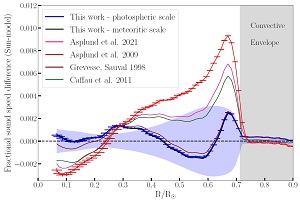Observational constraints on the origin of the elements. IV. Standard composition of the Sun
- Details
- Published on 20 May 2022
Vol. 661
9. The Sun and the Heliosphere
Observational constraints on the origin of the elements. IV. Standard composition of the Sun

For over two decades, stellar astrophysics has faced the so-called solar abundance crisis: solar structure models computed using the observed elemental abundances for the Sun were in conflict with the solar interior properties independently determined through helioseismology. Magg et al. analyzed the solar chemical composition again, coupling new non-local thermodynamical equilibrium (LTE) atomic models with three-dimensional simulations of solar convection to better represent the solar atmosphere.They also used two independent descriptions of the atomic properties of neutral oxygen — the most critical element for helioseismic predictions. The corresponding two estimates of the oxygen abundance agree well, thus supporting their revised solar oxygen abundance, and their abundances for refractory elements agree with the composition of the CI chondrites — the primitive meteorites that still carry the chemical fingerprint of the early Solar System. Excitingly, the new abundances resolve the previous puzzling mismatch between the solar interior structures inferred from helioseismology and from solar evolution models. This suggests that the “solar problem” stemmed from slightly incorrect solar abundances, and that no non-standard physics — such as accretion of metal-poor material, energy transport by dark matter particles, or a revision of the opacities — needs to be invoked any longer.


